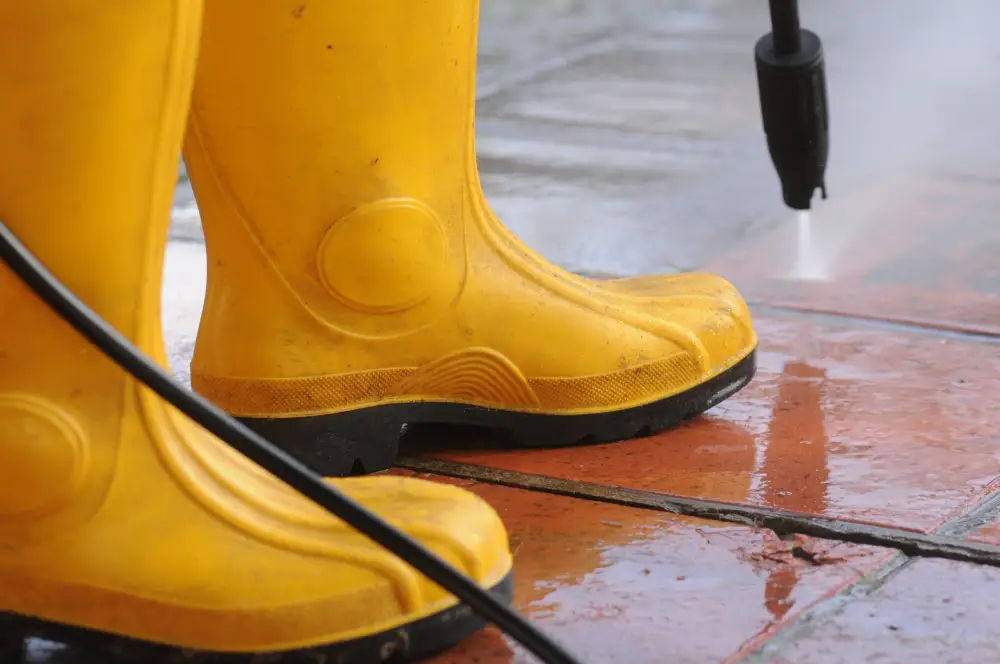
Power washing is an incredibly effective way to clean various surfaces around your home, from driveways and decks to siding and patios. However, it’s important to handle power washing equipment with care. The force behind the water is strong enough to clean deeply but also has the potential to cause injury or damage if not used safely. For homeowners looking to maintain the beauty of their property, understanding power washing safety tips is crucial.
Understanding Power Washing and Its Strength
Power washing uses high-pressure water sprays to remove dirt, mold, grime, and other contaminants. This process goes beyond the gentle rinse of a garden hose and demands respect for the equipment’s power. When performing power washing, you’re essentially wielding a tool that can blast away years of built-up debris but can also damage surfaces like wood, paint, or fragile materials if handled improperly.
Knowing how to safely manage this power washing force protects both you and your home’s surfaces. Always keep in mind that power washing is a tool that requires precaution and proper technique.
Essential Safety Gear for Power Washing
Before you start power washing near me your home, gearing up properly is a top safety tip. Protective equipment plays a significant role in preventing injuries during the cleaning process. At minimum, be sure to wear:
- Safety goggles to shield your eyes from debris and splashing water
- Gloves for a firm grip and to protect your hands from high-pressure water and cleaning chemicals
- Waterproof boots or shoes with good traction to avoid slipping on wet surfaces
- Ear protection, especially if using a gas-powered washer, to reduce noise exposure
Using the right safety gear ensures that power washing remains a safe task rather than a risky one.
Preparing Your Home and Work Area
Before starting the power washing job, preparation helps prevent accidents and damage:
- Clear the area of outdoor furniture, plants, and decorations.
- Cover nearby electrical outlets and meters to avoid water intrusion.
- Inspect surfaces for cracks, loose siding, or fragile spots that could be damaged by high pressure.
- Make sure pets and children are indoors and at a safe distance.
Preparing thoughtfully sets the stage for a smooth and safe power washing experience.
Using the Right Equipment and Settings
Choosing the correct pressure washer and nozzle is key to safe and effective power washing. Not every surface can handle the same intensity:
- Use a lower PSI setting for delicate surfaces like wood siding or painted areas.
- Hard surfaces like concrete and brick can usually handle higher pressures but still require care.
- Opt for a wider spray nozzle angle, such as 25 to 40 degrees, to distribute pressure more evenly and reduce the risk of damage.
Starting with a low pressure and gradually increasing it if needed keeps your power washing from causing unintended harm.
Safe Operating Tips for Power Washing
While power washing, follow these safety practices to avoid injury or property damage:
- Never point the spray at people, pets, or yourself. The jet is strong enough to break skin.
- Hold the wand securely with both hands to manage recoil or sudden movements.
- Maintain a steady distance—typically 1 to 2 feet—from the surface being cleaned.
- Move the wand in smooth, consistent motions to avoid concentrating pressure in one spot.
- Avoid using power washers near electrical fixtures, outlets, or power lines.
- Keep hoses and cords out of walkways where they could be tripped over.
These operational tips help you stay in control and reduce the risk of accidents.
Handling Cleaning Chemicals Safely
Many power washing jobs involve detergents or specialty cleaning agents to boost cleaning power. When using any chemicals:
- Choose biodegradable and environmentally friendly options when possible.
- Read and follow all manufacturer instructions carefully for dilution and use.
- Wear protective gloves and avoid inhaling fumes.
- Keep chemicals away from plants and pets.
- Rinse thoroughly after application to ensure no residue is left behind.
Safe chemical handling is an integral part of power washing that homeowners should never overlook.
Managing Common Hazards During Power Washing
Power washing presents some unique hazards that demand attention:
- High-pressure water jets can cause serious injuries, including deep cuts and bruising. Never direct the stream at anyone.
- Electrical risks arise when using electric-powered washers near water or damaged cords.
- Trip hazards from hoses and cords cluttered across the work area.
- Flying debris caused by water dislodging dirt or loose materials at high speed.
- Fatigue from holding equipment for extended periods, which can lead to loss of control.
Being aware of these risks helps maintain a safe environment while power washing.
Proper Maintenance and Storage of Power Washing Equipment
Keeping your power washing equipment in good condition supports ongoing safety:
- Inspect hoses, nozzles, and cords for wear or damage before each use.
- Replace worn parts promptly rather than risking leaks or malfunctions.
- Avoid cleaning the equipment with its own water stream to prevent damage.
- Store in a dry, safe place away from extreme temperatures.
- Follow manufacturer recommendations for winterizing or seasonal storage.
Well-maintained tools are less likely to cause injury or breakdowns during use.
Tips for Choosing When and Where to Power Wash
Not every day or surface is ideal for power washing. Consider the following:
- Pick dry, mild weather conditions. Avoid windy or rainy days when control and visibility are hampered.
- Avoid power washing directly on delicate plants or vulnerable outdoor fabrics.
- Stay off fragile surfaces like roof shingles or painted panels that could be damaged by strong jets.
- Pay attention to the area’s slope and footing to avoid slips or falls.
Smart timing and location choices keep power washing a productive and safe cleaning method.
FAQs About Power Washing Safety
How close should I hold the power washing nozzle to the surface?
Maintain about 1 to 2 feet distance to avoid damage to surfaces while still cleaning effectively.
Can power washing damage my wooden deck?
Yes, if used with too high pressure or too close a nozzle. Use a lower PSI and a wider angle nozzle for wood.
What personal protective equipment is essential for power washing?
Protective goggles, gloves, non-slip waterproof footwear, and ear protection are recommended safety gear.
Is it safe to pressure wash near electrical outlets?
No, it’s best to cover outlets and keep the power washing stream away from electrical fixtures to avoid shock risks.
Can I use any detergent with my power washer?
No, only use detergents designed for power washing and follow dilution instructions carefully.
What should I do if I get injured by a power washer?
Seek medical attention immediately. Power washing injuries can look minor but might require professional treatment.
How often should I inspect my power washing equipment?
Inspect before every use for any signs of wear or damage to hoses, nozzles, and cords.
Can children operate a power washer?
No, operating power washers requires careful handling and should only be done by responsible adults.
What is the safest way to start power washing a surface?
Start with low pressure and a test area to ensure no damage occurs, then gradually increase if needed.
How should I store my power washer when not in use?
Store in a dry, safe place, inspect for any damage before storing, and follow any winterizing instructions if applicable.
Power washing offers homeowners a powerful way to refresh and maintain their property’s exterior. By respecting the strength of the tool and following these safety tips, you ensure that your power washing experience is both effective and risk-free. Always remember that preparation, protective gear, and cautious operation are your best allies for safe power washing around your home.
Hose Bros Inc
38 Comanche Cir, Millsboro, DE 19966, United States
(302) 945-9470
